Jesse Josytewa Vintage Navajo Sterling Silver Bracelet white buffalo turquoise
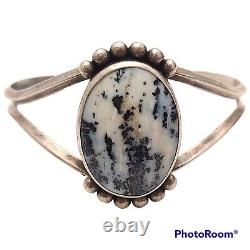
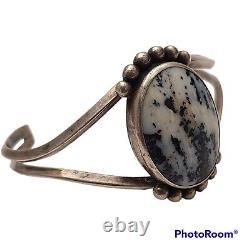
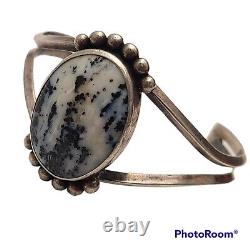
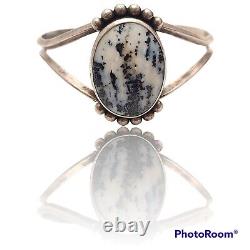
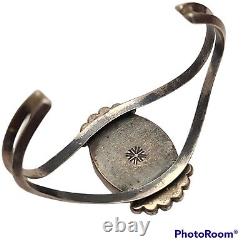
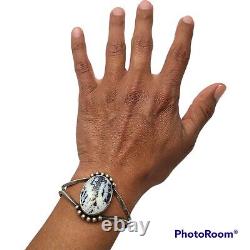
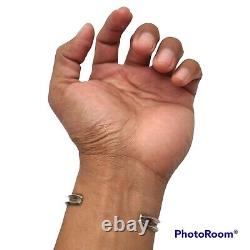
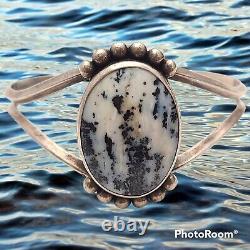
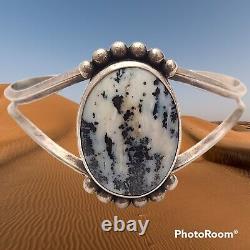
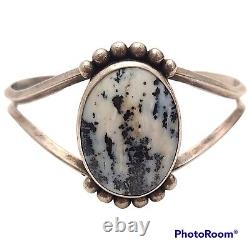

Vintage Handmade Native American Jesse Josytewa Sterling Silver Bracelet. Hopi silversmith Jesse Josytewa used a repeating water symbol motif on this traditional style Hopi bracelet.
Desert dwellers for thousands of years, the Hopi honor and celebrate the life-giving rains that fall from the clouds. Much of Hopi ceremonialism is centered on prayers for water. Design elements associated with water are a common pattern on Hopi art, both jewelry and pottery. The artist adorned this bracelet with a exquisite white buffalo turquoise in the center silver raindrops on each side fantastic White Buffalo Turquoise is from the Tonopah, Nevada area and runs from a clean white to a slightly off white in yellows, browns and blues.
White Buffalo Turquoise is found in black Churt or Mangonese so its matrix is usually black, there is occaisional black spiderweb stones which are rarely found. There is also occurances of a redish brown colored matrix in White Buffalo Turquoise but it is less promenant. In 1938, Harold Colton and his wife Mary Russell Colton of the Museum of Northern Arizona began a program to encourage Hopi jewelers to create a unique style of jewelry that would be distinctively Hopi. Silversmiths incorporated designs that were similar to those used on Hopi pottery.
In order to help jewelers market their jewelry, the Coltons initiated the Hopi Craftsman Exhibit. At the beginning of World War II, the project slowed due to a lack of materials and given the fact that many Hopi men joined the war effort. After World War II, Hopi artist Fred Kabotie and Hopi silversmith Paul Saufkie joined forces and established a program to teach Hopi veterans silversmithing skills.
Their goal was to give returning veterans a new profession. Kabotie was in charge of the artistic design and Saufkie taught the technical elements of silverworking. It was during this time that the overlay technique was established and perfected.After the first group of veterans graduated, the Hopi Silvercraft Cooperative Guild was formed. The Guild became instrumental in the training and education of a generation of Hopi artisans. This bracelet is a reflection of the techniques and design elements that were initiated during the time period after World War II at the Hopi Silvercraft Cooperative Guild. It is signed with Jesse Josytewa's hallmark- the Snow flake star.
It dates from the last quarter of the twentieth century. I have been unable to find any biographical information on the artist.I welcome any input from others if you have any information. Bracelet size 5 plus 1"½ gap wide 1"½×7mm weight 24.9 grams great addition to your collection lovely piece of art? This item is in the category "Collectibles\Cultures & Ethnicities\Native American: US\1935-Now\Jewelry". The seller is "joseeligogarciaciachino" and is located in this country: US.
This item can be shipped to United States, Canada, United Kingdom, Denmark, Romania, Slovakia, Bulgaria, Czech Republic, Finland, Hungary, Latvia, Lithuania, Malta, Estonia, Australia, Greece, Portugal, Cyprus, Slovenia, Japan, China, Sweden, South Korea, Indonesia, Taiwan, South Africa, Belgium, France, Hong Kong, Ireland, Netherlands, Poland, Spain, Italy, Germany, Austria, Bahamas, Israel, Mexico, New Zealand, Philippines, Singapore, Switzerland, Norway, Saudi Arabia, United Arab Emirates, Qatar, Kuwait, Bahrain, Republic of Croatia, Malaysia, Chile, Colombia, Costa Rica, Panama, Trinidad and Tobago, Guatemala, Honduras, Jamaica, Antigua and Barbuda, Aruba, Belize, Dominica, Grenada, Saint Kitts-Nevis, Saint Lucia, Montserrat, Turks and Caicos Islands, Barbados, Bangladesh, Bermuda, Brunei Darussalam, Bolivia, Egypt, French Guiana, Guernsey, Gibraltar, Guadeloupe, Iceland, Jersey, Jordan, Cambodia, Cayman Islands, Liechtenstein, Sri Lanka, Luxembourg, Monaco, Macau, Martinique, Maldives, Nicaragua, Oman, Pakistan, Paraguay, Reunion.- Tribal Affiliation: Navajo
- Artisan: jesse josytewa
- Country/Region of Manufacture: United States
- Handmade: Yes
- Modified Item: No
- Culture: Native American: US

